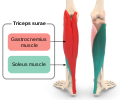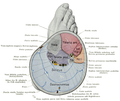Triceps surae muscle
Muscle group in the calf of the leg
The triceps surae is a pair of muscles located at the back of the lower leg, commonly referred to as the calf. It is composed of the gastrocnemius muscle and the soleus muscle. These muscles are crucial for movements such as walking, running, and jumping.
Anatomy[edit]
The triceps surae is made up of two major muscles:
Gastrocnemius[edit]
The gastrocnemius muscle is the larger and more superficial of the two muscles. It has two heads, the medial and lateral, which originate from the femur. The gastrocnemius crosses both the knee and ankle joints, contributing to its role in knee flexion and plantarflexion of the foot.
Soleus[edit]
The soleus muscle lies beneath the gastrocnemius. It originates from the tibia and fibula and does not cross the knee joint. The soleus is primarily responsible for plantarflexion of the foot and is active during standing and walking.
Function[edit]
The primary function of the triceps surae is to facilitate plantarflexion of the foot at the ankle joint. This action is essential for pushing the body forward during walking and running. The gastrocnemius also assists in knee flexion due to its attachment above the knee joint.
Innervation[edit]
The triceps surae is innervated by the tibial nerve, which is a branch of the sciatic nerve. This nerve provides the necessary signals for muscle contraction and coordination.
Blood Supply[edit]
The blood supply to the triceps surae is primarily provided by the posterior tibial artery and its branches. Adequate blood flow is essential for muscle function and recovery.
Clinical Significance[edit]
Injuries to the triceps surae, such as strains or tears, are common in athletes and can result from overuse or sudden movements. Conditions like Achilles tendinitis can also affect the function of these muscles.
Related pages[edit]
Gallery[edit]
-
Diagram of the triceps surae
-
Video of triceps surae function
-
Animation of triceps surae movement
-
Illustration of the gastrocnemius
-
Illustration of the soleus
-
Detailed anatomy of the calf muscles
-
Historical anatomy illustration
-
Cross-section of the lower leg
References[edit]
- Gray, Henry. Gray's Anatomy: The Anatomical Basis of Clinical Practice. 41st edition. Elsevier.
- Moore, Keith L., et al. Clinically Oriented Anatomy. 7th edition. Lippincott Williams & Wilkins.
Ad. Transform your life with W8MD's Budget GLP-1 injections from $75


W8MD offers a medical weight loss program to lose weight in Philadelphia. Our physician-supervised medical weight loss provides:
- Weight loss injections in NYC (generic and brand names):
- Zepbound / Mounjaro, Wegovy / Ozempic, Saxenda
- Most insurances accepted or discounted self-pay rates. We will obtain insurance prior authorizations if needed.
- Generic GLP1 weight loss injections from $75 for the starting dose.
- Also offer prescription weight loss medications including Phentermine, Qsymia, Diethylpropion, Contrave etc.
NYC weight loss doctor appointmentsNYC weight loss doctor appointments
Start your NYC weight loss journey today at our NYC medical weight loss and Philadelphia medical weight loss clinics.
- Call 718-946-5500 to lose weight in NYC or for medical weight loss in Philadelphia 215-676-2334.
- Tags:NYC medical weight loss, Philadelphia lose weight Zepbound NYC, Budget GLP1 weight loss injections, Wegovy Philadelphia, Wegovy NYC, Philadelphia medical weight loss, Brookly weight loss and Wegovy NYC
|
WikiMD's Wellness Encyclopedia |
| Let Food Be Thy Medicine Medicine Thy Food - Hippocrates |
Medical Disclaimer: WikiMD is not a substitute for professional medical advice. The information on WikiMD is provided as an information resource only, may be incorrect, outdated or misleading, and is not to be used or relied on for any diagnostic or treatment purposes. Please consult your health care provider before making any healthcare decisions or for guidance about a specific medical condition. WikiMD expressly disclaims responsibility, and shall have no liability, for any damages, loss, injury, or liability whatsoever suffered as a result of your reliance on the information contained in this site. By visiting this site you agree to the foregoing terms and conditions, which may from time to time be changed or supplemented by WikiMD. If you do not agree to the foregoing terms and conditions, you should not enter or use this site. See full disclaimer.
Credits:Most images are courtesy of Wikimedia commons, and templates, categories Wikipedia, licensed under CC BY SA or similar.
Translate this page: - East Asian
中文,
日本,
한국어,
South Asian
हिन्दी,
தமிழ்,
తెలుగు,
Urdu,
ಕನ್ನಡ,
Southeast Asian
Indonesian,
Vietnamese,
Thai,
မြန်မာဘာသာ,
বাংলা
European
español,
Deutsch,
français,
Greek,
português do Brasil,
polski,
română,
русский,
Nederlands,
norsk,
svenska,
suomi,
Italian
Middle Eastern & African
عربى,
Turkish,
Persian,
Hebrew,
Afrikaans,
isiZulu,
Kiswahili,
Other
Bulgarian,
Hungarian,
Czech,
Swedish,
മലയാളം,
मराठी,
ਪੰਜਾਬੀ,
ગુજરાતી,
Portuguese,
Ukrainian



